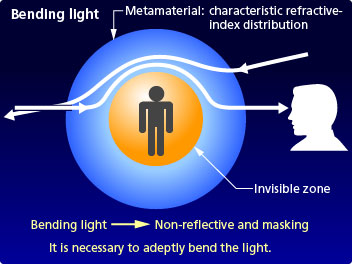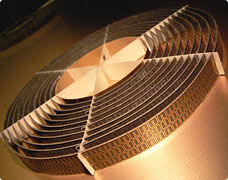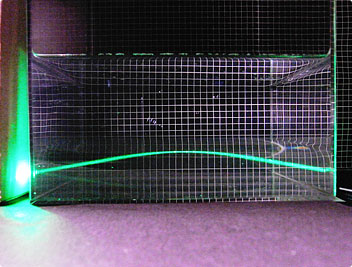If only I had an invisibility cloak... A fantastical item that appears in tales dating back to ancient times and more recently the realm of cinema, the invisibility cloak is becoming a practical reality through the power of science. While there are many nefarious reasons that people might want to conceal themselves, a wealth of dreams for the future are being pinned on this modern and magical cloak.
Invisibility cloak in fiction

Kriemhild mourns Siegfried ©akg/PPS
Why would someone want to become invisible? Invisibility cloaks have appeared in various stories, such as Doraemon and Harry Potter. An invisibility cloak even appears in the phenomenally popular epic poem the Niebelungenlied (the Song of the Niebelungs), which was written around 1200, as well as in related works.
As the story goes, far across the seas in the distant country of Iceland there lived a strong and beautiful queen named Brünhild. She would engage the brave warriors who came to seek her hand in marriage in contests, such as spear throwing, and invariably triumph, taking their lives as her prize. Gunther, the king of Burgundy, wishes to make this matchless woman his queen, and commands the hero Siegfried to help him. It is then that Siegfried's Tarnkappe ("invisibility cloak") comes into play.
Brünhild responds to King Gunther's challenge by hurling a spear that took three people to carry, and throwing a rock that twelve people could barely lift. However, with the aid of Siegfried, concealed by his cloak, King Gunther prevails. King Gunther and Brünhild are then married, as are Siegfried and Kriemhild, Gunther's beautiful young sister. However, Brünhild is highly distrustful, and on their wedding night King Gunther once again has to call on Siegfried for assistance.
Years later, however, Brünhild learns of Siegfried's involvement in the events of the wedding night through a quarrel with Kriemhild, who is stricken with grief at the stain on her honor. To dispel her anguished thoughts, the retainer Hagen kills Siegfried.
Although the invisibility cloak was a source of tragedy in that tale, the story now is that the power to freely manipulate light is real. In 2006, it was announced that the invisibility cloak could become a reality, and this instantly attracted worldwide attention.
Talk of an invisibility cloak over the past few years

If light from behind bends around an object, what is behind the object will be visible. If light from in front is also not reflected or diffused, it will be impossible to perceive the object.
Not everything we desire becomes the subject of scientific research. Although invisibility cloaks have featured in stories since olden times, only very recently has the conversation entered the realm of the practical. A UK group led by Professor John B. Pendry of Imperial College London first ignited the debate. Having conducted research into special "designer" materials known as metamaterials, Professor Pendry's group announced in 2006 that creating an invisibility cloak using such materials was in fact possible.
The mechanism used to make objects invisible is easy to understand if the question of why objects are visible is considered. Two principal factors allow us to verify an object's existence with our eyes. One, the object blocks light coming from behind it. Two, the object reflects and diffuses light that falls upon it, and our eyes are able to perceive this light. If light can be manipulated in such a way as to suppress these two phenomena, it would be as if the object were not there. Metamaterials are what make this invisible state possible. These materials are imbued with properties and functions that transcend the intrinsic capabilities of naturally occurring materials. The structure of the material is crafted at an extremely small scale to produce the desired properties and functions.
In 2006, the same year that Professor Pendry announced his group's theory, Professor David Smith and Professor David Schurig of Duke University in the USA actually succeeded in developing a metamaterial that acts as an invisibility cloak in the microwave spectrum. Microwaves have a longer wavelength than visible light. For his invisibility cloak, Professor Smith fashioned a microscopic geometrical pattern out of thin copper wiring laid down on fiberglass. Shielding rainclouds with this metamaterial, for example, would cause them to disappear from weather radar, which uses microwaves to detect objects.

The metamaterial Professor David Smith and Professor David Schurig devised as an invisibility cloak for the microwave spectrum. The cloak, which is 12.7 cm in size, features a set of ten concentric fiberglass rings of varying radii lined up with one another, and a large number of geometric patterns approximately 3 mm square made out of fine copper wiring arrayed on top of the rings.
In this simulation, the object to be hidden is in the middle and the observer is at the right. When there is no invisibility cloak, light from behind the object is diffracted, diffused, and reflected, and does not reach the observer (see left diagram). With the invisibility cloak applied, even when the object is at the center, the light is essentially unaffected by the object and reaches the observer (see right diagram).
The material used to fashion an invisibility cloak

As shown in the photograph, light bends as it descends deeper into a concentrated saline solution. Bending light in this manner is easy, but difficult to control precisely.
Making objects invisible to the human eye requires an invisibility cloak that covers the visible-light spectrum. Like microwaves, visible light is also made up of electromagnetic waves, which have both an electrical field and a magnetic field. However, the wavelengths of visible light are much shorter than those of microwaves, making them harder to manipulate. The principles of how to do so are becoming clear, however.
To effectively bend light requires controlling the refractive index with extreme precision. The refractive index must be made lower in the center, increased in step with the light's proximity to the periphery, and made equal to the refractive index of air (1.003) at the boundary with the atmosphere. Merely changing the refractive index, as shown in the photograph, is not difficult; however, the only way to control the refractive index with extreme precision and produce an invisibility cloak is to use a metamaterial designed precisely for that purpose.
The reflection of light from the surface of an invisibility cloak must also be zero. No naturally occurring material can perform this feat. Accordingly, Dr. Takuo Tanaka, associate chief scientist at Japan's Institute of Physical and Chemical Research (RIKEN), has proposed the first ever metamaterial that reflects absolutely no light.
Each substance or object has its own characteristic refractive index, n, which determines how light propagates through it. The refractive index is determined by the relative permittivity, ε, and the relative permeability, μ, according to the equation (n=√ε×√μ). The relative permittivity expresses the extent of the interaction between the substance and the light's electrical field, while the relative permeability expresses the degree of interaction between the substance and the light's magnetic field.

Numerous nanosized coils made of metal, pointing in every direction, are inlaid in a resin made of a base material such as glass or plastic. As light passes through the resin, current flows in the coils. Since the magnetic field this current generates can influence light's magnetic field, it will alter the resin's relative permeability.
There is no naturally occurring material that interacts with light's magnetic field. All natural materials have a relative permeability of 1.0. However, Dr. Tanaka discovered how to create a metamaterial that reflects no light at all, by making its relative permeability greater than 1.0. This material consists of a structure fashioned out of numerous nanosized coils made of metal, and is several orders of magnitude smaller than the metamaterial Professor David Smith produced, enabling it to alter the relative permittivity and relative permeability of visible light, which has shorter wavelengths than microwaves. Dr. Tanaka is currently developing a metamaterial that will fulfill this function in the infrared spectrum, which has wavelengths somewhat longer than visible light.
A promising future with the invisibility cloak
If the nanostructure within a material can be manipulated at will, it is possible to increase or decrease the substance's relative permittivity and relative permeability, and even to make them both negative. If the relative permittivity and relative permeability are both negative, the refractive index will also be negative. In addition to the invisibility cloak, a range of other applications for metamaterials with such completely new optical properties is conceivable.
For example, a lens produced with a refractive index five times greater than existing lenses by means of higher relative permittivity and relative permeability could be five times thinner. The use of thin, lightweight lenses in glasses and other products would certainly make for greater convenience and an improved quality of life. This technology could also contribute enormously to solving the world's energy problems. Standard solar batteries in use today, for example, can essentially only process visible to near-infrared light. A metamaterial that could convert mid-infrared or far-infrared light to visible light would greatly improve power generation efficiency.
Using metamaterials with a negative refractive index might even make it feasible to manufacture revolutionary new products equal to or even better than the invisibility cloak, such as an optical microscope that would make the molecules and atoms in living organisms visible to the eye.
With the emergence of metamaterials, major changes in optical science are already underway. As for the horizons that will open up in the wake of these metamaterials that have liberated us from a relative permeability of 1.0, a world far beyond our imagination no doubt awaits.
Collaboration on materials / Date of article posted
Dr. Takuo Tanaka, associate chief scientist at the Institute of Physical and Chemical Research (RIKEN) / May 2012

